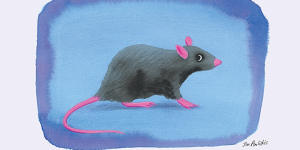So my son and I built an aviary extension for the new arrivals. We pushed our practical skills to the limit. It was intense. It was bonding. It was deeply unequal. After about 20 minutes he quit and went inside. I pushed on,sweating and swearing as I cut myself on the wire. It was done.

Illustration:Jim Pavlidis
But would it be safe? We had heard quails had to be protected from rats at all costs. Rats can get into almost anywhere. And there was a stinking big brown rat that lived in the compost heap.
The solution:use a thief to catch a thief. I put our four pet rats in the quail cage and watched them. They raced around the bottom,looking for an exit. They climbed the walls and shimmied across the front. But they couldn’t get out. I did it twice more on different days,just to make sure. Then I made my fatal mistake. I put them in and went off to do something else.
I suspect they planned this from the start. Having lulled me into a false sense of security,they climbed up and squeezed out through a gap in the roof. They were gone.
When their deception was discovered,the kids all blamed me:“You lost our pets.”
We soon spotted them,and they hadn’t gone far. They had made a new friend. He was burly. Brown. The bad boy of backyard rodents. The type to eat your avocados off your tree and shit on your path. I was immediately suspicious of his intentions.
Now,rat-fanciers don’t like to talk about this. But their domestication efforts are fur-deep. Yes,they’ve produced fancy rats much easier on the eye than a wild rat. You can have dumbo rats,with giant,cute ears. You can have velveteen rats with fur like a fleece,bred to look like tiny grey sheep. You can have agouti;hooded;curly-haired rex rats;satin-furred rats;and even hairless rats,which look like sad penises. But they are still the same species:the Norwegian rat,the brown rat,the ship rat,which,with the black rat,raid our pantries,live under our houses,stow away on ships and generally do very well out of humanity.
And now our four precious fancy rats had done a runner with old mate. Pipsqueak. Millie. Apricot. Dune.
For days,they stayed out there,doing who knows what. They ran wild down the side of our neighbours fence. They popped their heads out of holes to taunt us. Apricot gave me side-eye. They’d flown the coop. They didn’t need us any more.
Then they ran out of food. The outside world was cold. It had cats in it. Old mate wasn’t a great provider. One by one,they came back. Sheepish. Dirty. Ravenous. But curiously,plumper.
Over the next couple of weeks,three of our darlings slowed down and filled out. Only Millie was left,scaling the cage restlessly. The others grew and grew.
As this was happening,I had taken refuge in my favourite place:Denial. Perhaps they were bulking up for winter? Were they gluten intolerant? We rang my brother-in-law,who happens to be a rodent expert. He had spent time trying to rescue the Bramble Cay melomys,which had recently gone extinct. He had rid rice paddies of black rats in Vietnam. And he had been paid well for rat seek-and-destroy missions in some of Australia’s largest bakeries. (“The things I’ve seen have turned me off bread forever”).
He found our predicament amusing,but said it was unlikely our pets were up the duff. Melbourne,after all,had black rats,not brown. It looked fairly brown,I ventured. “Black rats can look brown. So you’re safe. They can’t breed. No babies.”
A week went by,and Pipsqueak looked like a filled water balloon hanging from the tap – tiny head,enormous tummy. She moved slowly and did a lot of panting. Apricot’s belly looked like it might explode. Under the fur,something moved. We had to face facts. Perhaps Melbourne had brown rats,after all.
It was soon to have more. And then,it happened. We woke to the sound of squeaking. I felt terror grip me. There they were. Dozens of them. Pink. Mewling. Squeaking.
One of the mothers went on a power trip. Dune had at least 15 of her own. But she wanted more. So she went around the cage,stealing every baby she could. Piling them up,a pink wriggling mass. She was the alpha mother. She would rear them all.
A day later,Dune had discovered her error. The sound of her demanding children filled the air. She tried to sleep,but there was no sleep. There would never be sleep again. She fled,but she was caged. The other mothers showed no interest in sharing the load. Life kept providing lessons.
But what could we do? How could we house 40-plus rats?
Colleagues advised the farm solution. Others gently let me know they had a cat for hire. Some suggested releasing them under the house of my enemy. I did not have an enemy.
Could we sell them on Gumtree to Melbourne’s other rat-owning eccentrics,just as we had bought ours? Would our bold mix of genetics mean ours were unsaleable? Or would our approach of breeding across the class divide pay off? Would rat fanciers hear our tale of fancy bayside rat meets unpolished gem of the north and be taken?
There was,I decided,only one way to find out. Stay tuned.
Doug Hendrie is a Melbourne writer.
The Opinion newsletter is a weekly wrap of views that will challenge,champion and inform your own..